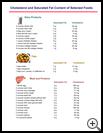
Cholesterol Screening or Testing
What is cholesterol?
Cholesterol is a type of fat in the blood. It is needed for building hormones and cells. Everyone needs to have some cholesterol in their blood. The body makes most of its own cholesterol. However, what you eat also affects the level of cholesterol. Cholesterol comes from animal products such as meat, eggs, and dairy products. If you eat less cholesterol and saturated fat, you will have less cholesterol in your blood.
Cholesterol has several parts: high-density lipoproteins (HDL), low-density lipoproteins (LDL), and triglycerides. HDL is called the "good" cholesterol because it carries cholesterol away from the arteries to the liver. The liver helps the body get rid of cholesterol. The LDL is called "bad" cholesterol. If you have too much LDL, cholesterol builds up in the arteries. As a result your arteries become clogged. The HDL, LDL, and triglycerides together are called "total cholesterol."
Why is having low cholesterol important?
Children who have higher-than-normal levels of cholesterol have a higher risk of eventually developing clogged or narrowed blood vessels that carry blood to the heart muscle. Lower cholesterol levels can reduce the risk of heart disease.
Reducing children's cholesterol levels with proper diet and exercise is believed to give children a better chance of having low cholesterol when they are adults.
What are normal and high cholesterol levels?
Cholesterol levels for children are as follows:
Total LDL HDL
Cholesterol Cholesterol Cholesterol
Acceptable less than 170 less than 110 above 45
Borderline 170-199 110-129 40-45
Abnormal 200 or higher 130 or higher less than 40
Should my child's cholesterol be checked?
If your child is at high risk, your child’s cholesterol should be checked every 3 to 5 years. Your child is at high risk if he or she:
- Is overweight or obese
- Has high blood pressure
- Smokes cigarettes
- Has diabetes
- Has a father or grandfather who had heart disease before the age of 55, or a mother or grandmother who had heart disease before the age of 65
- Has a relative with high cholesterol or a lipid disorder
Talk with your child’s healthcare provider about how often to check your child's cholesterol. Control of cholesterol levels in childhood can reduce risk of heart disease in young adult life.
If your child’s total cholesterol level is borderline high (between 171 and 200), your child will start a program that includes a low-fat diet and exercise. Your child’s total cholesterol will probably be rechecked every year
Children with total cholesterol greater than 200 will have a lipid panel test. This test measures the levels of LDL, HDL, and triglycerides, as well as total cholesterol. These levels will be checked again after 2 to 4 months of treatment. Usually the test is done the first thing in the morning, before your child eats or drinks anything except water. Your child must be fasting for the test to be accurate.
Your child may need to take medicine to lower cholesterol if:
- One or two tests show your child has high levels of cholesterol
- Your child is at high risk for heart disease
- Diet and exercise do not lower cholesterol enough
Talk with your healthcare provider about what is best for your child.
Should my whole family be checked?
If your child has very high cholesterol, everyone in your family should have their total cholesterol checked. It is helpful to start the whole family on a healthier diet and exercise program.
Last modified: 2017-04-11
Last reviewed: 2017-04-11

